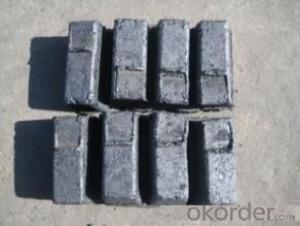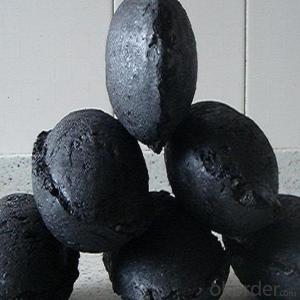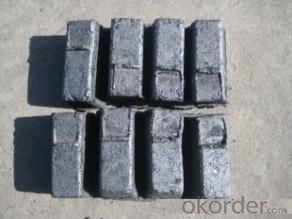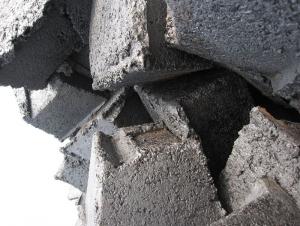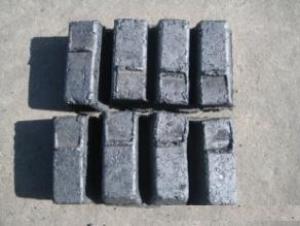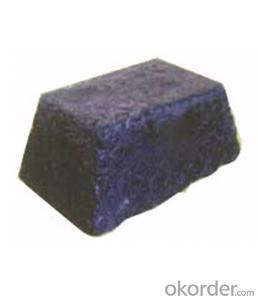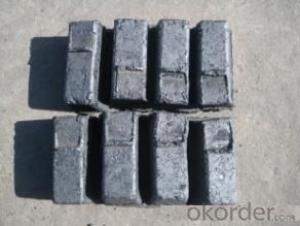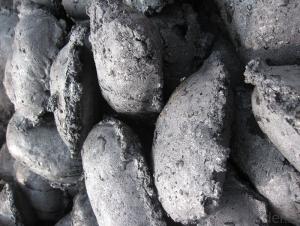Carbon Electrode Paste with high quality
- Loading Port:
- Lianyungang
- Payment Terms:
- TT OR LC
- Min Order Qty:
- 20 m.t.
- Supply Capability:
- 800 m.t./month
OKorder Service Pledge
OKorder Financial Service
You Might Also Like
Spcifications
1:carbon eletrode paste
2:for ferroalloy,calcium carbide manufacture
3:HS 3801300000,YB/T5212-1996,ISO9001:2008
Product Description
Carbon Electrode Paste is a self-baking electrode used in submerged arc furnaces for delivering power to the charge mix. Electrode Paste is added to the top of the electrode column in either cylindrical or briquette form. As the paste moves down the electrode column the temperature increase causes the paste to melt and subsequently bake forming a block of electrically conductive carbon. Electrode Paste is essentially a mix of Electrically Calcined Anthracite (ECA) or Calcined Petroleum Coke (CPC) with Coal Tar Pitch.
Graphite/Carbon Electrode Paste Specification:
| PARAMETER UNIT GUARANTEE VALUE | ||||||
| Ash.( % ) | 4.0 max | 5.0 max | 6.0 max | 7.0 max | 9.0 max | 11.0 max |
| V.M (%) | 12.0-15.5 | 12.0-15.5 | 12.0-15.5 | 9.5-13.5 | 11.5-15.5 | 11.5-15.5 |
| Compress Strength. | 18.0 min | 17.0 min | 15.7 min | 19.6 min | 19.6 min | 19.6 min |
| Specific Resistance | 65 max | 68 max | 75 max | 80 max | 90 max | 90 max |
| Bulk Density | 1.38 min | 1.38 min | 1.38 min | 1.38 min | 1.38 min | 1.38 min |
Picture:
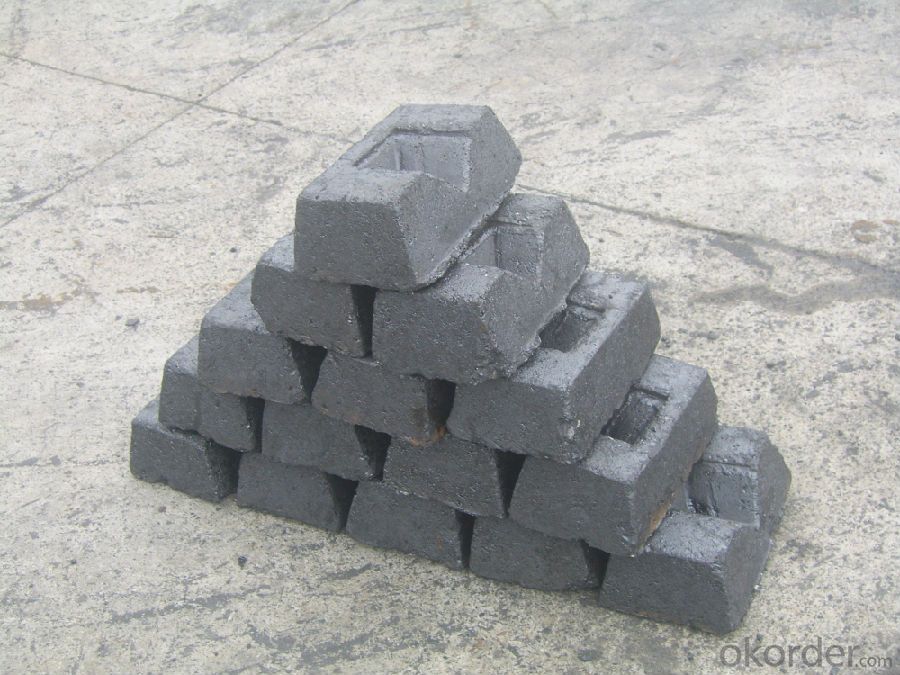
- Q: What are carbon credits?
- The aim of carbon credits is to lessen greenhouse gas emissions and combat climate change by using a market-based mechanism. These credits measure and quantify the reduction, removal, or avoidance of one metric ton of carbon dioxide (or its equivalent) from being released into the atmosphere. The concept behind carbon credits is rooted in the belief that certain activities or projects can offset the emissions caused by other activities. For example, renewable energy projects like wind farms or solar power plants can generate carbon credits by replacing the need for fossil fuel-based electricity generation. Similarly, projects focused on reforestation or afforestation can absorb carbon dioxide from the atmosphere and generate credits. These carbon credits can be purchased and sold in the carbon market, enabling companies or individuals to compensate for their own emissions by buying credits from projects that have successfully reduced or removed carbon dioxide from the atmosphere. This supports environmentally friendly initiatives and contributes to the overall reduction of greenhouse gases. The carbon credit system functions by creating financial incentives for activities that reduce emissions. It encourages businesses to invest in cleaner technologies and practices by assigning a monetary value to the reduction of carbon emissions. This drives the transition to a low-carbon economy and promotes sustainable development. Carbon credits play a crucial role in international efforts to tackle climate change. They are often used as a compliance mechanism for countries or companies to meet their emission reduction targets, as outlined in international agreements like the Kyoto Protocol or the Paris Agreement. Additionally, they contribute to the overall objective of limiting global temperature rise by encouraging emission reductions beyond regulatory requirements. While carbon credits have faced criticism for potentially allowing companies to continue polluting by simply purchasing credits, they remain an important tool in the fight against climate change. They provide economic benefits to sustainable projects and encourage the adoption of cleaner technologies, ultimately helping to mitigate the environmental impact of human activities.
- Q: How does deforestation contribute to carbon dioxide levels in the atmosphere?
- Increased carbon dioxide levels in the atmosphere are significantly influenced by deforestation. Trees play a crucial role as natural carbon sinks, absorbing carbon dioxide through photosynthesis and storing it in their trunks, branches, and leaves. However, when forests are cleared or burned down for purposes like agriculture, logging, or urbanization, the stored carbon is released back into the atmosphere as carbon dioxide. The removal of trees directly diminishes the planet's ability to absorb carbon dioxide, resulting in an imbalance in the carbon cycle. Furthermore, deforestation disrupts the carbon cycle by hindering the process of photosynthesis, which is vital for converting carbon dioxide into oxygen and organic compounds. Additionally, deforestation indirectly contributes to increased carbon dioxide levels in the atmosphere through the decomposition of organic matter. When trees are cut down or burned, the stored carbon they contain is released as carbon dioxide, intensifying greenhouse gas emissions. Moreover, deforestation impacts the water cycle, leading to dryer conditions in affected areas. This causes soil to become arid, making it less suitable for plant growth and reducing the potential for carbon absorption through reforestation efforts. The cumulative effect of deforestation on carbon dioxide levels is significant. Studies indicate that deforestation accounts for approximately 10-15% of global carbon emissions, thus making it one of the leading contributors to climate change. The rise in atmospheric carbon dioxide levels, along with other greenhouse gases, contributes to the greenhouse effect, trapping heat in the atmosphere and causing global warming. To mitigate climate change and decrease carbon dioxide levels, it is crucial to address deforestation. Implementing sustainable forestry practices, promoting reforestation efforts, and protecting existing forests are essential steps in preserving carbon sinks and reducing greenhouse gas emissions.
- Q: What are the effects of carbon emissions on the stability of mangrove forests?
- The stability of mangrove forests is significantly impacted by carbon emissions. These ecosystems are highly vulnerable to climate changes, and increased carbon emissions contribute directly to global warming and climate change. One of the main consequences of carbon emissions on mangrove forests is the rise in sea levels. When carbon dioxide is released into the atmosphere, it traps heat and warms the planet. This, in turn, causes the melting of polar ice caps and glaciers, resulting in higher sea levels. The increased sea levels pose a threat to mangroves as they are adapted to grow in areas where they are exposed to both saltwater and freshwater. With rising sea levels, mangroves may experience more flooding, which can lead to their submersion and eventual death. Additionally, carbon emissions also play a role in ocean acidification. When carbon dioxide dissolves in seawater, it creates carbonic acid, which alters the pH balance of the ocean. Mangroves rely on the ocean for their nutrients and reproductive processes. Ocean acidification can hinder the availability of vital nutrients like nitrogen and phosphorus, necessary for the growth and survival of mangroves. Furthermore, the acidification of seawater can negatively impact the reproduction and development of mangrove species, leading to a decline in their population. Furthermore, carbon emissions contribute to changes in weather patterns, including an increase in the frequency and intensity of storms and hurricanes. Mangroves serve as natural barriers that protect coastal areas from the destructive impacts of these extreme weather events. However, with intensified storms and hurricanes, the stability of mangrove forests is compromised. Strong winds, heavy rainfall, and storm surges can uproot or damage mangrove trees, disrupting their structure and reducing their ability to provide coastal protection. Finally, carbon emissions also contribute to the overall warming of the planet, which can result in changes in precipitation patterns. Mangroves rely on a delicate balance of freshwater and saltwater for their survival. Alterations in precipitation patterns, such as prolonged droughts or increased rainfall, can disrupt this balance and have negative effects on mangroves. Droughts can cause water scarcity, stressing mangroves and making them more susceptible to diseases and pests. Conversely, excessive rainfall can dilute the salinity of mangrove habitats, affecting their growth and reproduction. In conclusion, carbon emissions have harmful effects on the stability of mangrove forests. Rising sea levels, ocean acidification, changes in weather patterns, and alterations in precipitation patterns all contribute to the degradation and loss of mangrove ecosystems. It is crucial to reduce carbon emissions and mitigate the effects of climate change to ensure the long-term survival and stability of mangrove forests.
- Q: What is electrical carbon?
- Different uses have different varieties, according to the use of electric carbon varieties can be divided into:(1) sliding contact carbon brushes and carbon sliders for all kinds of motor brushes.(2) various carbon and graphite contacts used in high power switches, relays, etc..(3) with various carbon arc lighting, carbon arc gouging, spectral analysis and arc furnace.(4) all kinds of high purity graphite electrodes, insulation and supporting elements for electric vacuum devices.(5) various electrodes used in dry cells and electrolytic cells.(6) the resistance effect of carbon. Made of various resistance, post, communication with the microphone carbon sand, resistance heating elements etc..
- Q: How does carbon dioxide affect ocean acidity?
- Carbon dioxide affects ocean acidity by increasing the concentration of carbonic acid in the water. When carbon dioxide dissolves in seawater, it reacts with water molecules to form carbonic acid, which then dissociates into hydrogen ions and bicarbonate ions. The increase in hydrogen ions leads to a decrease in pH, making the ocean more acidic. This process is known as ocean acidification and can have harmful effects on marine life, particularly on organisms with calcium carbonate shells or skeletons, as the increased acidity can make it harder for them to build and maintain their structures.
- Q: Material characteristics of carbon fiber
- Carbon fiber is a kind of new material with excellent mechanical properties due to its two characteristics: carbon material, high tensile strength and soft fiber workability. The tensile strength of carbon fiber is about 2 to 7GPa, and the tensile modulus is about 200 to 700GPa. The density is about 1.5 to 2 grams per cubic centimeter, which is mainly determined by the temperature of the carbonization process except for the structure of the precursor. Generally treated by high temperature 3000 degrees graphitization, the density can reach 2 grams per cubic mile. Coupled with its weight is very light, it is lighter than aluminum, less than 1/4 of steel, than the strength of iron is 20 times. The coefficient of thermal expansion of carbon fiber is different from that of other fibers, and it has anisotropic characteristics. The specific heat capacity of carbon fiber is generally 7.12. The thermal conductivity decreases with increasing temperature and is negative (0.72 to 0.90) parallel to the fiber direction, while the direction perpendicular to the fiber is positive (32 to 22). The specific resistance of carbon fibers is related to the type of fiber. At 25 degrees centigrade, the high modulus is 775, and the high strength carbon fiber is 1500 per centimeter.
- Q: Just come out to work, do activated carbon, often see carbon materials and carbon materials, I do not know what the difference, trouble you!
- Carbon refers to elements. Carbon materials usually refer to materials that contain carbon and are the main bodyCarbon is a carbon containing substance of no composition and property consisting of carbon elementsCarbon materials are usually specified, especially carbon and graphite materialsCarbon material is a broad carbon containing materialAbove.
- Q: How does carbon affect the formation of landslides?
- Carbon does not directly affect the formation of landslides. However, the presence of carbon in the form of organic matter can contribute to the stability of slopes as it plays a role in soil structure and moisture retention.
- Q: Which carbon content is larger, steel or pig iron?
- The carbon content of pig iron is large. The carbon content of pig iron is usually 2.5%--4%, and the carbon content of steel is 0.05% - 2%
- Q: What are the different methods of measuring carbon dioxide levels in the atmosphere?
- There exist various techniques for assessing carbon dioxide levels in the atmosphere. These techniques encompass direct measurement, remote sensing, and ice core analysis. Direct measurement stands as the most precise and extensively employed approach. It encompasses collecting air samples from numerous locations worldwide and analyzing them using gas analyzers. These analyzers possess the capability to gauge the concentration of carbon dioxide in the air, typically expressed in parts per million (ppm). Remote sensing represents an alternative method for measuring carbon dioxide levels. It involves the utilization of satellite-based instruments to observe and quantify the quantity of carbon dioxide present in the Earth's atmosphere. These instruments can detect the absorption and scattering of sunlight caused by carbon dioxide molecules, thereby rendering valuable data concerning its concentration. Ice core analysis constitutes a historical technique for assessing carbon dioxide levels. Scientists delve deep into polar ice sheets and procure ice cores. These ice cores harbor trapped air bubbles from hundreds or even thousands of years ago. By analyzing the carbon dioxide content within these bubbles, scientists can recreate past atmospheric carbon dioxide levels and juxtapose them with contemporary levels. Each of these methods possesses its own merits and limitations. Direct measurement furnishes real-time data and precise measurements, albeit necessitating an extensive network of monitoring stations worldwide. Remote sensing offers a global perspective and the ability to cover large areas, yet it may struggle to resolve fine-scale spatial variations. Ice core analysis delivers valuable long-term historical data, but its applicability is confined to specific regions and solely permits indirect measurements. The amalgamation of these techniques empowers scientists to obtain a comprehensive comprehension of carbon dioxide levels in the atmosphere, aiding in the monitoring and evaluation of the impact of human activities on climate change.
Send your message to us
Carbon Electrode Paste with high quality
- Loading Port:
- Lianyungang
- Payment Terms:
- TT OR LC
- Min Order Qty:
- 20 m.t.
- Supply Capability:
- 800 m.t./month
OKorder Service Pledge
OKorder Financial Service
Similar products
Hot products
Hot Searches
